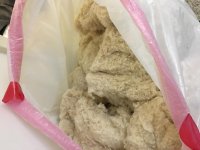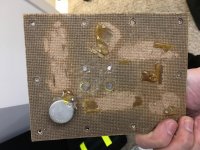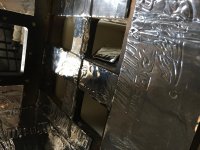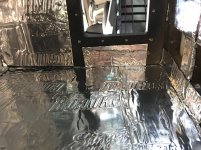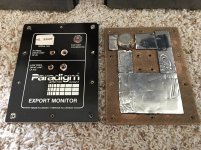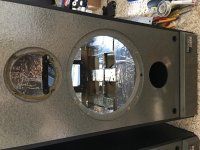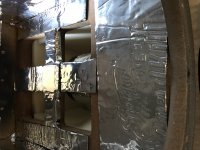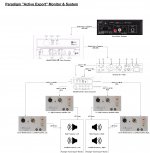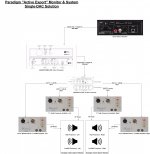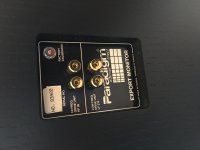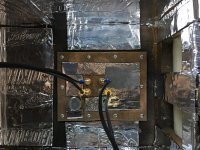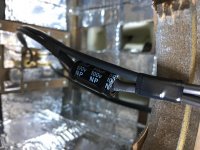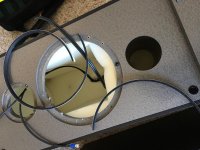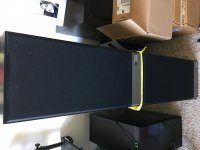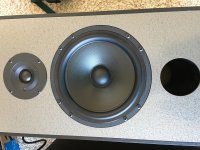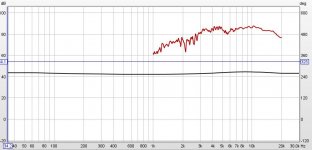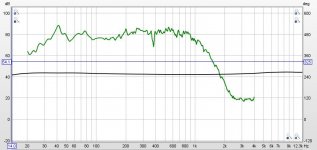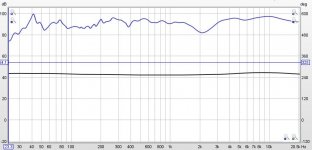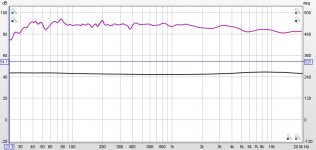I've had a pair of Paradigm Export Monitor speakers from 1989 for years, a hand-me-down from my uncle who had them since new. They aren't bad at all, though a little boomy on the low end, and responded well to parametric EQ via miniDSP.
Paradigm | Bookshelf | Monitor | Classic Collection | Export Monitor | Specifications
It's time for their refurbishment and, hopefully, upgrade. I have lots of DIY experience building amps and preamps and all kinds of digital sources, but this is my first loudspeaker project, so I hope to learn a lot along the way.
I intend to make this an active pair, using a miniDSP 2x4HD for crossover, and driving the woofer with my Hypex nCore 400 monoblocks. Tweeter amp is TBD (suggestions welcome), but I'll cable up something for testing purposes when I get to that.
The speaker is of good construction, but no more than that. Bracing is only adequate, and it was stuffed with a tremendous quantity of now-shifting and unglued shredded cotton. The cabinet definitely needed more damping.
Because additional bracing isn't really going to be convenient, I decided to dampen the cabinet walls with Stinger Roadkill, a heavy Dynamat alternative - foil over butyl backing. This was applied everywhere on the interior, resulting in a significant reduction in resonance. The butyl product was also applied to the port exterior, which reduced its tendency to ring.
I took out the crossovers, and will wire the drivers directly to the four binding posts (to be replaced) on the back panel. Tweeter will have a 50uF capacitor in line for protection.
Memory foam will be used on all cabinet walls, and I will experiment with whether to stuff the cabinet in the OEM cotton, or use additional memory foam, depending on measurement results.
I'll be posting pictures and updates as I make progress. Any feedback, tips, or commentary welcome!
Paradigm | Bookshelf | Monitor | Classic Collection | Export Monitor | Specifications
It's time for their refurbishment and, hopefully, upgrade. I have lots of DIY experience building amps and preamps and all kinds of digital sources, but this is my first loudspeaker project, so I hope to learn a lot along the way.
I intend to make this an active pair, using a miniDSP 2x4HD for crossover, and driving the woofer with my Hypex nCore 400 monoblocks. Tweeter amp is TBD (suggestions welcome), but I'll cable up something for testing purposes when I get to that.
The speaker is of good construction, but no more than that. Bracing is only adequate, and it was stuffed with a tremendous quantity of now-shifting and unglued shredded cotton. The cabinet definitely needed more damping.
Because additional bracing isn't really going to be convenient, I decided to dampen the cabinet walls with Stinger Roadkill, a heavy Dynamat alternative - foil over butyl backing. This was applied everywhere on the interior, resulting in a significant reduction in resonance. The butyl product was also applied to the port exterior, which reduced its tendency to ring.
I took out the crossovers, and will wire the drivers directly to the four binding posts (to be replaced) on the back panel. Tweeter will have a 50uF capacitor in line for protection.
Memory foam will be used on all cabinet walls, and I will experiment with whether to stuff the cabinet in the OEM cotton, or use additional memory foam, depending on measurement results.
I'll be posting pictures and updates as I make progress. Any feedback, tips, or commentary welcome!
I've attached photos of the progress thus far:
- Shredded cotton mess removed.
- Crossover ripped from the glue on the back panel, and panel scraped clean.
- Interior covered in foil-backed butyl for damping (significant improvement in cabinet damping, especially on sides, port, and vented brace)
- Memory foam installed in lower port compartment, pending installation everywhere else.
- Foil backed butyl installed on cleaned-up rear panels, pending installation of new binding posts and driver wiring.
Attachments
Things I could use some experienced advice on, so far:
- There's nothing wrong with the woofer or the tweeter, strictly speaking, but I have considered refurbishing particularly the tweeter. It's a 104mm flange, so I'd need something of the same size, since I'm not equipped for woodworking, and I don't think this really would be worth the trouble anyway. Should I both replacing the tweeter, with, say, the 104mm Mundorf AMT, or the Morel 104mm? They're both 8 Ohm, and would fit, just not sure if it's worthwhile to swap only tweeter, since I don't intend to swap woofer at this time.
- Anybody have suggestions on a class-D amp for the tweeter? I have something to use for testing, but I need something for final tuning and long-term use. Woofers will be powered by my nCore 400 monoblocks (which I love).
- Are there experienced opinions on whether or not I should simply seal this port, and have a sealed cabinet speaker? I have no sub, but, that said, the low end response of this speaker was always more than enough for my purposes (music only, mostly jazz, classical, chamber-pop).
Memory foam ? It only sucks volume.
The little panel holding the binding posts, that needs to be changed. Put something thicker, metal ?! The pot or L-pad doesn't need to be there since you "go active".
TBH I would leave them like that. Put the binding posts* and put the original crossover ( well away ) out of the box. That's already a big improvement.
*In case you would want to "go purist", eliminate them and use solid wire to go thru the holes ( hot glue around ) to attach directly to the speakers and then to the crossover.
The little panel holding the binding posts, that needs to be changed. Put something thicker, metal ?! The pot or L-pad doesn't need to be there since you "go active".
TBH I would leave them like that. Put the binding posts* and put the original crossover ( well away ) out of the box. That's already a big improvement.
*In case you would want to "go purist", eliminate them and use solid wire to go thru the holes ( hot glue around ) to attach directly to the speakers and then to the crossover.
Memory foam ? It only sucks volume.
The little panel holding the binding posts, that needs to be changed. Put something thicker, metal ?! The pot or L-pad doesn't need to be there since you "go active".
TBH I would leave them like that. Put the binding posts* and put the original crossover ( well away ) out of the box. That's already a big improvement.
*In case you would want to "go purist", eliminate them and use solid wire to go thru the holes ( hot glue around ) to attach directly to the speakers and then to the crossover.
Thanks for the advice!
Regarding memory foam, I was using it against the cabinet walls for dampening. Do you recommend another material? Should I simply re-stuff with the shredded cotton, or maybe polyfill?
And yes, the intent is solid wire (with only a cap on the tweeter for protection) to the binding posts, so I can do what I want externally with active crossover.
Well, the cap still ought to be external !
(I said to eliminate the binding posts 😱 But that's really too hard, I know)
Shredded cotton is still one of the best materials, after sheep's felt.
You can put some long nails attached to the internals to keep it firm. Still lots of glue has to be used to keep the insulation attached to the interiors.
That memory foam seems pretty unuseful, as it doesn't have any property ( acoustically speaking )
(I said to eliminate the binding posts 😱 But that's really too hard, I know)
Shredded cotton is still one of the best materials, after sheep's felt.
You can put some long nails attached to the internals to keep it firm. Still lots of glue has to be used to keep the insulation attached to the interiors.
That memory foam seems pretty unuseful, as it doesn't have any property ( acoustically speaking )
Interesting, why capacitor outside the box? I figured I would leave it inside the box simply because it's a protective measure, no matter what I plan to do with the crossover (externally).
Oh, and re: the pot on the board, I just left it because it would make a nasty hole. I will eventually rework these plates in metal.
Oh, and re: the pot on the board, I just left it because it would make a nasty hole. I will eventually rework these plates in metal.
I have also been thinking of going with a active crossover on a 3 way build i just completed. Have you done any research on what brand of active crossover you will use?
I have also been thinking of going with a active crossover on a 3 way build i just completed. Have you done any research on what brand of active crossover you will use?
Yes, at least some. My planned system is as attached, but has some open items. In particular:
- I don't really understand why I am using my Emotiva DC-1 in this chain, and now allowing the MiniDSP 2x4 HD to be my only DAC, since it is capable of volume control, and is also effectively going to be a DAC in the chain anyway. Does anybody have any thoughts on this? Is there a point in having a high-quality DAC upstream of an inevitable lower quality DAC?
- I have not decided what amplifier to use for the tweeters. Likewise, any thoughts on this are welcome. Woofers will use nCore monoblocks because that's what I know, have, and love.
In your case hifi1971, you could use the miniDSP 8x10 HD and otherwise basically the same system as represented here, if you were so inclined.
Attachments
I've got one of those jobs that doesn't leave a lot of time for anything else, so progress was slow for a while, but I had a couple hours to keep moving recently. I swapped out the stock binding posts with some new ones from Dayton and reinstalled the backplate. This will be re-worked in metal eventually, but at least I can get the speaker running again and get some preliminary results by reusing what was there. Sealed with speaker gasket tape and screwed back in to the unit.
Attachments
I soldered a capacitor in-line with the tweeter lead, for protection (I am running an external active crossover, so I don't want someone who doesn't know this accidentally hooking up to the tweeter directly and pumping 20hz test tones... and that someone would be me).
Attachments
And now on to the lining. I did go with memory foam after all, having done some research on the matter. I did not decide to add any stuffing beyond the lining, though the speaker was originally quite stuffed full of shredded cotton. I retained the shredded cotton in case this was a bad decision, and may experiment with adding some in the future.
Memory foam was stapled to the cabinet interior to keep it in place, and surrounds but does not obstruct the port. This will remain a ported design, for now.
Memory foam was stapled to the cabinet interior to keep it in place, and surrounds but does not obstruct the port. This will remain a ported design, for now.
Attachments
I broke out my UMIK-1 and calibration file, checked levels, and went for some measurements. Samples of some are attached.
- tweeter-raw is a sweep tone sent only to the tweeter, from 1khz-20khz.
- woofer-raw is a sweep tone sent only to the woofer, from 20hz-4khz.
- combined-with-crossover is a sweep tone from 20hz-20khz after I set the crossover at 1776khz, Linkwitz-Riley with a 24db slope.
- combined-with-crossover-and-eq is a sweep tone from 20hz-20khz with the aforementioned crossover and some parametric EQ curve to flatten things out a little.
Attachments
In the end, this is a very good sounding speaker now. I'm interested to hear opinions on whether I should try stuffing/sealing/different crossovers. I will be integrating subwoofer(s) eventually, and changing out amplification so all four channels come from the same amp, but otherwise, I'm thus far quite pleased with results here, and it's been a great way to get in to active crossovers and DIY loudpeakers without much investment, since I already had these lying around.
Hi Syz,
Very nice work. It does look however like there may be a little phase matching issue. Your combined, un-EQ'd graph is what makes me wonder. Even if you can EQ it flat at one point, fixing this issue makes less EQ necessary and blending of the two drivers easier and less troublesome off-axis.
Did you measure the acoustic offset of the two drivers?
Best,
Erik
Very nice work. It does look however like there may be a little phase matching issue. Your combined, un-EQ'd graph is what makes me wonder. Even if you can EQ it flat at one point, fixing this issue makes less EQ necessary and blending of the two drivers easier and less troublesome off-axis.
Did you measure the acoustic offset of the two drivers?
Best,
Erik
Hi Syz,
Very nice work. It does look however like there may be a little phase matching issue. Your combined, un-EQ'd graph is what makes me wonder. Even if you can EQ it flat at one point, fixing this issue makes less EQ necessary and blending of the two drivers easier and less troublesome off-axis.
Did you measure the acoustic offset of the two drivers?
Best,
Erik
Thanks Erik! That's the kind of feedback I was looking for... I am a relative novice here, and, though I understand phase issues, I don't necessarily know how to go about fixing them.
Everything I've done so far is in REW. Would you recommend attempting to solve phase issues with a FIR bank in RePhase?
Syz,
Sorry I'm afraid I'm less of a DSP than a passive guy! 🙂
Usually people start by adding delay (just delay!) to the tweeter. What I don't know is how to simulate this for optimal phase alignment.
In the passive world, we can see the phase matching directly, and can adjust our crossover until we get it right. I have no idea how to do it with DSP.
However, it's worth looking at an example. Take a look at this blog post and look towards the bottom for the "Driver Phase Matching" section.
Best,
Erik
Sorry I'm afraid I'm less of a DSP than a passive guy! 🙂
Usually people start by adding delay (just delay!) to the tweeter. What I don't know is how to simulate this for optimal phase alignment.
In the passive world, we can see the phase matching directly, and can adjust our crossover until we get it right. I have no idea how to do it with DSP.
However, it's worth looking at an example. Take a look at this blog post and look towards the bottom for the "Driver Phase Matching" section.
Best,
Erik
Awesome, thanks for the blog post, I'll file this away and do another update when I have a chance to implement a time delay / something more sophisticated.
- Home
- Loudspeakers
- Multi-Way
- The "Active" Paradigm Export Monitor Upgrade
